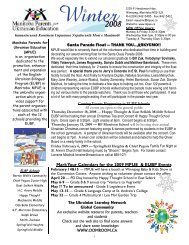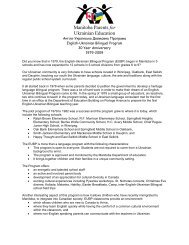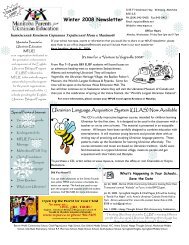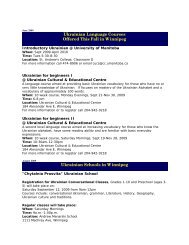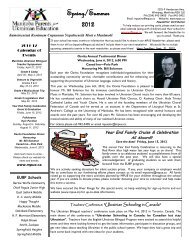Ukrainian Holy Week and Easter Traditions Христос Воскрес!
Ukrainian Holy Week and Easter Traditions Христос Воскрес!
Ukrainian Holy Week and Easter Traditions Христос Воскрес!
Create successful ePaper yourself
Turn your PDF publications into a flip-book with our unique Google optimized e-Paper software.
PASKA (<strong>Easter</strong> "babka")<br />
Starter: 2 oz. yeast (2 packages of dry yeast)<br />
1 tbsp. milk<br />
1 tbsp. sugar<br />
2-3 tbsp. water<br />
Dissolve the yeast in the above mixture; wait<br />
until it bubbles <strong>and</strong> then add<br />
4 cups sifted flour<br />
2 cups warm milk<br />
Mix all ingredients <strong>and</strong> wait until the dough<br />
rises.<br />
PASKA - <strong>Easter</strong> Ritual Bread<br />
The most honoured <strong>Easter</strong> bread was the paska <strong>and</strong> the preparation <strong>and</strong> baking of paska was considered one of the<br />
most important tasks of the year. People believed that the future could be predicted, depending on how this holiday<br />
bread turned out. Every homemaker wanted her paska to be the best <strong>and</strong> the biggest, therefore while baking it she performed<br />
various magical gestures <strong>and</strong> used incantations.<br />
The dough for the paska was kneaded in a trough which rested on a pillow so that the bread would be light. During the<br />
preparation the homemaker had to maintain pure thoughts. While the paska was in the oven no one was allowed to sit or<br />
make a loud noise for fear it would collapse in the oven. In some regions of Ukraine the man of the house stood guard in<br />
his front door lest someone enter <strong>and</strong> cast an evil spell while the paska was baking.<br />
A successfully baked paska brought great joy to the family. Wrapped in a rushnyk (ritual cloth), or placed in a basket, the<br />
paska was carried to church by the master of the house to be blessed in a ceremony following the Resurrection Mass on<br />
<strong>Easter</strong> morning. Other foods such as cheese, butter, salt, pork fat, horse radish, eggs, pysanky (<strong>Ukrainian</strong> <strong>Easter</strong> egg),<br />
ham, sausages, as well as various seeds were also brought to church for the blessing. Immediately after the ceremony<br />
the family would hurry home to share the blessed paska <strong>and</strong> thus begin <strong>Easter</strong> breakfast.<br />
The antiquity of the paska as a ritual bread is evidenced not only by the rituals performed during the preparations <strong>and</strong><br />
baking but also by the decorations which adorned this holiday bread. The top of the paska was covered with symbolic<br />
signs made of dough such as a cross, solar signs, rosettes, leaves, pine cones <strong>and</strong> sometimes even birds <strong>and</strong> bees.<br />
Most of these decorations were remnants of an ancient pagan religion tied to the cult of the sun <strong>and</strong> bread.<br />
To the mix add:<br />
8 cups flour<br />
3 whole eggs<br />
8 egg yolks<br />
1/4 lb. (or 8 tbsp.) sugar<br />
1/4 tsp. salt<br />
1 vanilla sugar<br />
lemon rind of 1 lemon<br />
juice of 1 orange<br />
1 jigger of rum or other spirits<br />
(br<strong>and</strong>y)<br />
1/4 lb. melted butter<br />
Article By: Lubow Wolynetz<br />
Curator of Folk Art<br />
Collection<br />
The <strong>Ukrainian</strong> Museum in<br />
New York City<br />
DECORATIONS<br />
FOR THE TOP OF THE PASKA:<br />
Mix all the ingredients together. Add butter at the very end. Knead well<br />
for about 1/2 to 3/4 of an hour, until the dough is elastic. The dough will<br />
be very stiff. If it is too stiff, add 1/4 cup milk. Place the dough in a warm<br />
spot <strong>and</strong> let it rise until double in bulk. When ready, fill greased <strong>and</strong><br />
floured pans 1/2 or 1/3 full with dough. Make dough decorations for the<br />
tops of the pasky: solar motifs, square crosses, scrolls, braids, rosettes,<br />
birds, etc. Place the pans in a warm spot <strong>and</strong> let the dough rise until it<br />
reaches the top of each pan. Brush the tops of the dough with an egg<br />
wash. Bake in a preheated oven at 400 for 10 minutes, <strong>and</strong> then at 325<br />
for additional 45 minutes. When done, take the pans out of oven <strong>and</strong><br />
wait until the pasky cool in the pans. Then, carefully take them out of the<br />
pans <strong>and</strong> place gently on a cloth-covered pillow. Allow to cool completely.<br />
INCANTATIONS for a successful paska. Upon placing the paska into the<br />
oven say: "<strong>Holy</strong> paska, be as gr<strong>and</strong> <strong>and</strong> beautiful as the sun, because<br />
we are baking you for the sun. Let all members of our family be healthy.<br />
Let our children grow up as quickly as you grow. "Come out as beautiful<br />
as you go in!"<br />
DO'S <strong>and</strong> DONT'S:<br />
• When preparing paska dough <strong>and</strong> during the kneading, think<br />
only good thoughts, shoo away all evil ones.<br />
• Don't let any of your neighbors or worse – strangers - come<br />
into the house when you are preparing the paska. They might<br />
put an evil eye on your paska <strong>and</strong> it will not rise as it should.<br />
Don't make any sudden noises while the paska is rising or<br />
while it is in the oven baking. Also, don't sit down while the<br />
paska is in the oven or it will become flat.<br />
• If you carefully follow all of the above instructions, the paska<br />
will be light, airy <strong>and</strong> tasty.<br />
6



